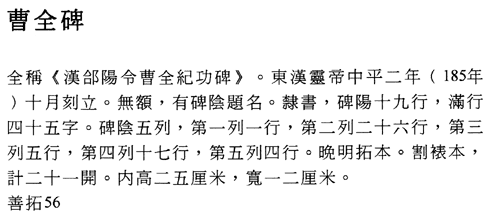 |
|
|
 |
Stele for Cao
Quan Eastern
Han dynasty (25�220 c.e.),
Zhongping reign period (184�188), dated 185 Unearthed
during the late Ming dynasty at Xinli village, Geyang County, Shaanxi Province;
stone engraved in clerical script; dimensions of original stele approx. 272.0 x
95.0 cm; stone now in the collection of the Forest of Stelae, Shaanxi
Provincial Museum, Xi'an, Shaanxi Province Album
of 42 leaves, ink rubbed on paper, accordion-style mounting between top and
bottom wooden boards; overall dimensions of album: 31.5 x 15.9 cm; each leaf:
approx. 31.4 x 15.7 cm; each rubbing panel: approx. 25.0 x 11.5-11.6 cm, except
first rubbing panel, 25.0 x 11.3 cm, and last rubbing panel: 24.8 x 12.1 cm Date
of rubbing not given, probably late Ming dynasty (1368�1644), between 1573 and
1644 Inventory number: Shanta 56 By
the Eastern Han period, especially from the mid-second century onward, stelae
were carved in profusion and bore lengthy inscriptions.� Many were erected to commemorate
individuals.� One such important stele
records the achievements of Cao Quan, magistrate of Geyang.� An example of jigong bei (stelae recording
good and noble deeds), this is one of the best preserved of the Han and
exhibits exceptional finesse.� It was
commissioned by 61 officials and residents of Geyang prefecture, in what is now
Shaanxi Province, to praise the virtues of the aristocratic Cao Quan and his
clan. The
rubbing of this stele, originally composed of one or more large sheets, was
subsequently cut into strips and remounted in its present format. |
 |